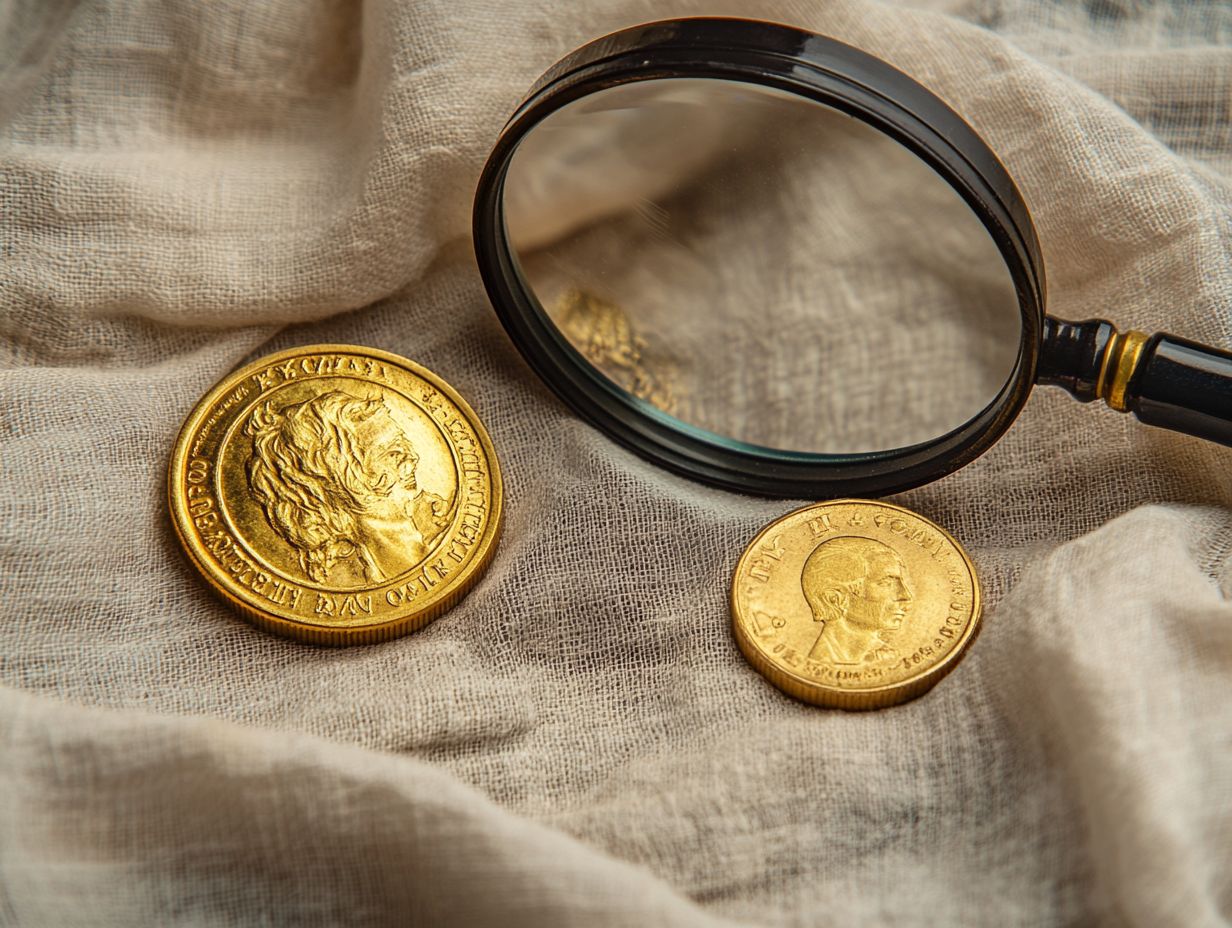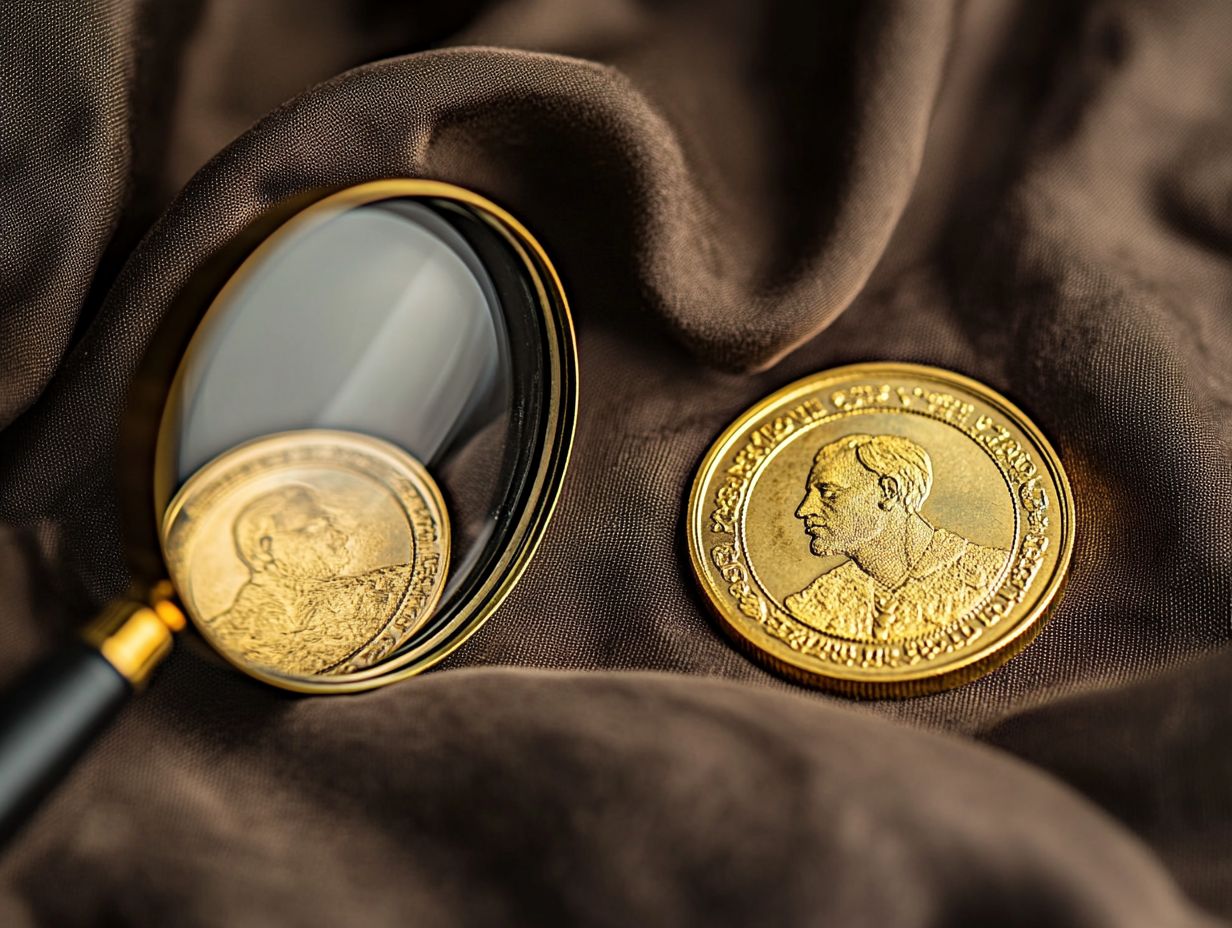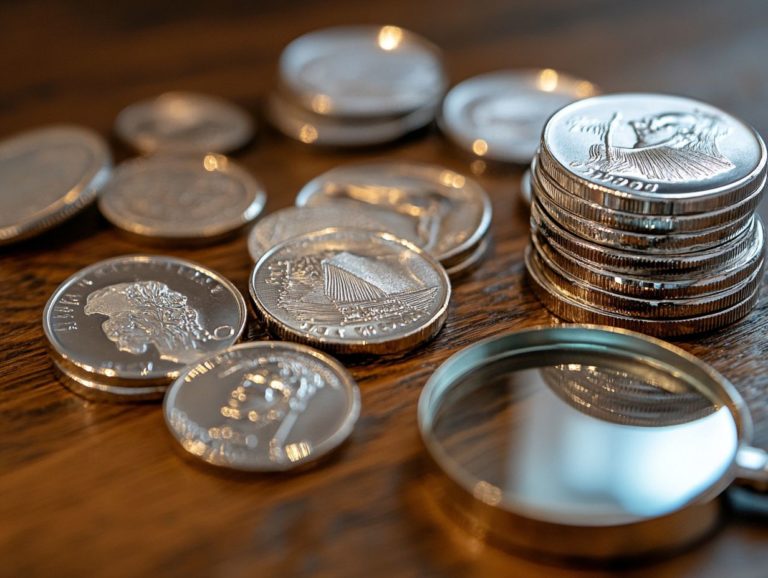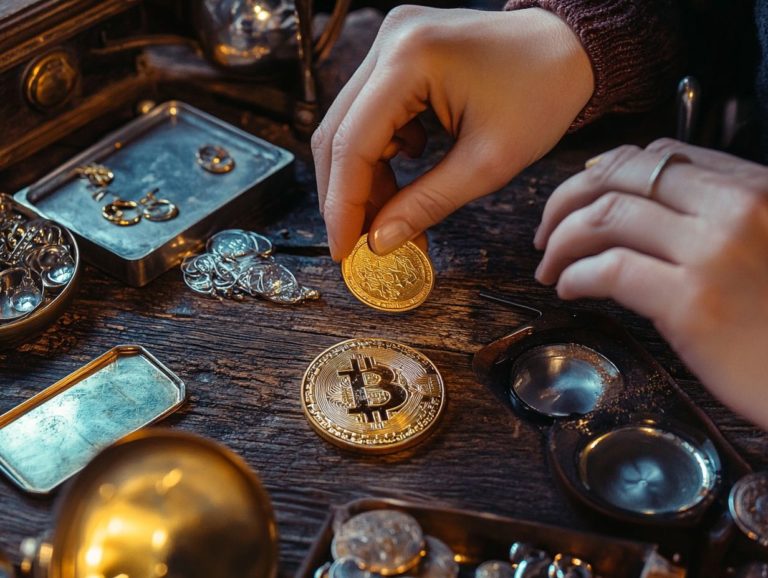How to Spot Counterfeit Gold Coins
Counterfeit gold coins are a significant concern for collectors and investors. Understanding how these fakes are made and the signs to watch for is essential to protect your investment.
This article explores various counterfeiting methods, including fake alloys and reproduction techniques. Knowing the key features and markings can help you identify counterfeit coins.
Get vital tips to ensure you buy only genuine gold coins from trustworthy sources. Act now to safeguard your collection!
Contents
- Key Takeaways:
- What are Counterfeit Gold Coins?
- Methods of Counterfeiting Gold Coins
- Signs of a Counterfeit Gold Coin
- How to Avoid Purchasing Counterfeit Gold Coins
- Frequently Asked Questions
- Can I use a magnet to spot counterfeit gold coins?
- What should I look for when examining a gold coin for authenticity?
- How can I tell if a gold coin has been tampered with?
- Are there specific markings or inscriptions that should raise suspicion?
- What is the best way to authenticate a gold coin?
- What should I do if I suspect a gold coin is counterfeit?
Key Takeaways:

Beware of fake gold alloys and reproduction techniques – these are common methods of counterfeiting.
Always check for weight, color, and engravings when buying gold coins. Buy from reputable sources and verify the authenticity through trusted experts or certification processes.
What are Counterfeit Gold Coins?
Counterfeit gold coins are replicas designed to look like genuine coins. They can be made from various materials and attract both novice and seasoned investors.
Spotting authentic gold requires careful observation and knowledge of unique features. A small mistake can lead to substantial financial loss.
Methods of Counterfeiting Gold Coins
The art of counterfeiting gold coins has evolved significantly. Counterfeiters use sophisticated techniques that can easily deceive even the most experienced investors.
From fake gold alloys to advanced reproduction methods, counterfeiters employ various strategies designed to replicate the weight and appearance of authentic coins.
Understanding these methods is crucial for collectors and investors. It helps ensure the authenticity of their purchases and protects their financial interests.
Fake Gold Alloys
Fake gold alloys are often made from cheaper metals like tungsten and lead. These materials mimic the weight of genuine gold bars and coins.
Manufacturers combine these metals with fillers to create a texture that resembles real gold. The visual appeal can be so convincing that it takes a keen observer to spot the differences.
To distinguish between fake alloys and genuine gold, tests like the acid test and X-ray fluorescence can be invaluable. You might also consider the magnet test; true gold is not magnetic.
Density tests can enable weight comparisons to further identify counterfeit pieces. Thorough testing is essential for serious collectors.
Reproduction Techniques

Counterfeiters have developed increasingly sophisticated reproduction techniques. These methods can produce counterfeit coins that easily evade initial scrutiny.
Advanced engraving and minting processes allow for meticulous replication of security features in genuine gold coins. As these techniques improve, you must stay vigilant.
Modern technologies include 3D printing and laser engraving, producing impressively accurate reproductions. Familiarize yourself with key security features like micro-engraved details.
Using advanced detection tools like ultrasonic testing can greatly help distinguish genuine coins from counterfeits. This knowledge preserves the integrity of your collection.
Signs of a Counterfeit Gold Coin
Identifying counterfeit gold coins requires you to recognize specific signs and physical characteristics that set them apart from genuine coins.
Look for discrepancies in weight, texture, and any fake markings or engravings, as these often reveal that the coin isn t genuine.
Understanding these telltale signs is crucial for collectors and investors like you. It helps safeguard your investments in gold and steer clear of costly pitfalls.
Physical Characteristics to Look For
It s important to know the physical characteristics to look for. You ll want to pay attention to weight, texture, and marks that show a coin s authenticity.
To kick off your evaluation, start by assessing the coin’s weight. Real gold possesses a distinct density, so a genuine gold coin will feel noticeably heavier than a fake one of similar size.
A precision scale can help you uncover any discrepancies, as authentic coins adhere to specific weight standards set by their mints. The texture of the coin s surface can also offer valuable clues.
Authentic gold will exhibit a smooth, consistent finish, in stark contrast to the unevenness typically found in counterfeits. Don’t overlook the importance of inspecting hallmarks. These should be clearly defined, making identification straightforward.
For added confidence, consider performing a scratch test or using acid tests to confirm the metal’s authenticity. This will empower you to make informed decisions as a collector.
Identifying Fake Markings and Engravings
Identifying fake markings and engravings is essential for you to distinguish counterfeit coins from the genuine article. Many counterfeiters strive to replicate the intricate details of authentic currency, but keen observation can unveil discrepancies that hint at a coin’s authenticity.
To enhance your examination process, consider using a magnifying glass or a jeweler’s loupe. This allows you to scrutinize the engravings closely, noting the depth and clarity of each line.
Authentic coins typically showcase fine details that are challenging to replicate. Inconsistencies like shallow engravings or smudges can serve as red flags for potential fakes.
Understanding the security features found in real gold coins, such as micro-markings and distinctive texture patterns, is crucial for your assessment. Pay special attention to the weight and metal composition; any deviations from standard measurements underscore the importance of thorough gold coin authentication.
How to Avoid Purchasing Counterfeit Gold Coins

To steer clear of counterfeit gold coins, it s vital for collectors and investors to act now. This means sourcing your purchases from reputable dealers and diligently verifying the authenticity of coins before committing to any investments.
Given the increasing prevalence of counterfeiting in today’s market, mastering the art of navigating this landscape is essential. Doing so will protect your investment and ensure that you acquire only genuine coins, elevating your collection.
Tips for Buying from Reputable Sources
When you re buying gold coins, sourcing from reputable dealers is absolutely essential. This practice not only boosts your chances of acquiring genuine coins but also significantly reduces the risk of falling prey to counterfeit scams.
Look for sources that display clear expertise in gold coin authentication and have a solid reputation for transparency and security features. To effectively identify trustworthy dealers, start by checking online reviews and ratings across various platforms.
Certifications from recognized industry organizations can serve as important indicators of reliability, while affiliations with professional groups add an extra layer of credibility. If you’re new to collecting, take the time to delve into a dealer s background explore their history in the market and any awards or recognitions they may have garnered.
Attending local coin shows or exhibitions can offer invaluable firsthand experience. This setting provides an excellent opportunity for you to ask questions and gain insights, ensuring you’re well-informed before making any purchases.
Do your research and make informed choices to protect your investment!
Verifying Authenticity of Gold Coins
As a collector or investor, verifying the authenticity of gold coins is crucial. There are effective methods to accomplish this, such as the acid test, magnet test, float test, and ping test.
Each technique gives a unique insight into whether a coin is made from pure gold.
- The acid test involves applying a special solution to a small scratch on the coin. A color change will indicate the gold’s purity.
- The magnet test is simple: check if the coin is attracted to a magnet. Genuine gold will not respond.
- The float test checks the coin s buoyancy in water to gauge its density and authenticity.
- The ping test requires you to gently tap the coin and listen for its distinct sound. A high-pitched tone usually indicates authenticity.
These methods provide valuable insights. However, if you’re uncertain, consult a professional.
Professionals have the expertise and tools to evaluate your coins accurately.
Frequently Asked Questions
Can I use a magnet to spot counterfeit gold coins?

No, gold is not magnetic. If a gold coin is attracted to a magnet, it s likely counterfeit, made of iron or steel.
What should I look for when examining a gold coin for authenticity?
Look for weight, size, and overall appearance. A genuine gold coin feels heavy and has a consistent size and design.
How can I tell if a gold coin has been tampered with?
Check the edges for signs of filing, scratching, or unevenness. Genuine gold coins should have smooth, even edges.
Are there specific markings or inscriptions that should raise suspicion?
Yes, watch for unusual or incorrect markings. Inconsistencies in the design or lettering can also be red flags.
What is the best way to authenticate a gold coin?
The most reliable method is to have it professionally authenticated and graded by a reputable coin dealer or a third-party grading service.
What should I do if I suspect a gold coin is counterfeit?
If you doubt a coin’s authenticity, do not sell or add it to your collection. Bring it to a professional for further examination.




